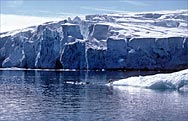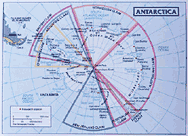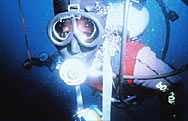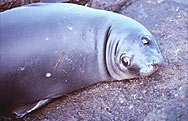 |
|
 |
History and Politics
“Antarctica” comes from the Greek Antarktikos, which means “opposite the Bear.” Arktos being the Great Bear, or Big Dipper, constellation above the North Pole.
Even before the discovery of Antarctica, ancient mapmakers included a “mythical” continent at the bottom of the Earth called “Terra Australis Incognita (The Unknown Southern Land).”
1773 -- British explorer Capt. James Cook and the crew of the Resolution and Adventure make the first recorded crossing of the Antarctic Circle, but never actually see the continent.
1820 -- Who first saw the continent is controversial. The Russian expedition leader Fabian Gottlieb von Bellingshausen, the Englishman Edward Bransfield, and the American
Nathaniel Palmer all claim first sightings in 1820.
1874 – HMS Challenger, on a four-year scientific cruise of the world, crosses the Antarctic Circle, becoming the first steamship to do so.
1879 -- The First International Polar Conference is held.
1895 -- The first party to actually land on the continent beyond the Antarctic Peninsula is part of a whaling expedition led by Norwegian Henrich Bull. They row ashore at Cape Adare in January.
1897 -- An expedition lead by Belgian Adrien de Gerlache becomes icebound off the Antarctic Peninsula and is forced to spend 13 months drifting in the pack ice. One crewman dies.
1899 -- The first deliberate expedition to spend a winter on the continent is led by Norwegian Carsten Borchgrevink, who had earlier been a member of Henrich Bull’s party. They are stationed at Cape Adare.
1902 – Robert Scott, Edward Wilson and Ernest Shakleton leave McMurdo Sound in the first serious attempt to reach the South Pole. At 82 degrees south they are forced to return.
1904 -- Scott’s British National Expedition establishes a base on Ross Island.
1905 – The International Geographical Congress decides to make Antarctica the main target of future exploration, launching an era of government-sponsored national expeditions. Within a short time, parties from Britain, German and Sweden are organized.
1907-09 – Ernest Shakelton establishes British Antarctic Expedition’s base on Ross Island.
1908 – Ernest Schakleton, Frank Wild, Eric Marshall and James Adams begin their attempt to reach the South Pole.
1911 -- Robert Scott’s second expedition sets out in spring from Ross Island in another attempt to reach the South Pole. Further to the east a Norwegian party lead by Roald Amundsen, who was a member of de Gerlache’s 1897 expedition, is also wintering in hopes of reaching the pole first. Better equipped and with a shorter distance to travel, the Amundsen party reaches the south geographic pole first.
1912 – Robert Scott, Edward Wilson, “Birdie” Bowers, Edgar Evans and Lawrence Oates reach the South Pole and discover the Norwegian flag flying there. All perish on the return journey.
1915 – Ernest Shackleton’s ship Endurance becomes trapped and is crushed by the sea ice of the Weddell Sea after a nine-month drift. The 28 men camp on the floating ice for a further five months before taking to the boats and reaching Elephant Island.
1922 – Ernest Shackleton, 48, dies of a heart attack on board the Quest on his final expedition to Antarctica.
1926 -- Australian Sir George Hubert Wilkins and his American pilot Carl Benjamin Eielson are the first to fly and airplane in Antarctica.
1929 -- U.S. Admiral Richard E. Byrd and three others take off in a Ford monoplane, becoming the first to fly over either pole in an airplane.
1934 – Admiral Richard Byrd begins his lone winter sojourn at his advance base 123 miles inland from the Bay of Whales. He is the first person to winter in the interior of the continent, but almost dies of carbon monoxide poisoning.
1935 -- Caroline Mikkelsen, whose husband is a Norwegian sea captain, becomes the first woman to land on the continent.
1935 – On their third attempt, American Lincoln Ellsworth and pilot Herbert Hollick-Kenyon become the first to fly across the continent.
1940 – The United States Services Expedition under Admiral Richard Byrd establishes Little America III base at the Bay of Whales.
1947 – Operation Highjump, organized by the U.S. Navy brings 4,000 men, 13 ships and 23 aircraft to Antarctica. A base is set up at Little America. Ice breakers are used for the first time, and two groups work around the continent. Large inland areas are mapped and 70,000 aerial photographs are taken.
1947-1948 -- Edith Ronnie and Jennie Darlington become the first women to winter in Antarctica. They accompanied their husbands on a private American expedition.
1959 -- To keep order between the countries, the Antarctic Treaty is signed in December in Washington. At the time of the treaty signing, Britain, New Zealand, Australia, France, Norway, Chile, and Argentina all had claims to land in Antarctica, although all claims are set aside so that all nations involved share their research efforts.
The treaty, which has been in place now for more than 40 years sets Antarctica aside as a site for peaceful scientific use only, banning military activity or nuclear testing, and limiting national programs to scientific research. The treaty also ensures the free exchange of information and scientists between countries and gives nations the right to inspect the operations of other countries. Further articles of the treaty outline all the area south of 60° S as being the jurisdiction of the South Pole.
|
 |
|
|
|




